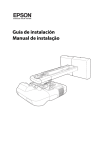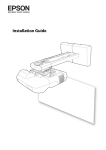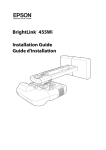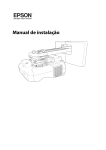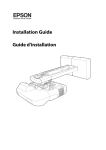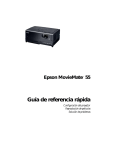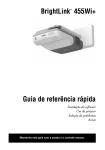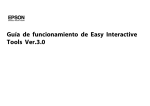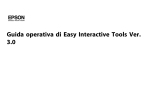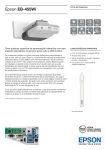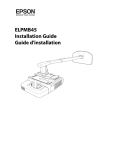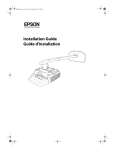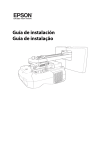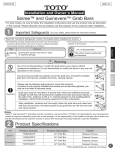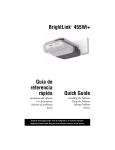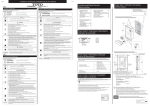Download Guía de instalación
Transcript
BrightLink 455Wi+ TM Guía de instalación Installation Guide Instrucciones de seguridad Para su seguridad, lea todas las instrucciones de esta guía antes de usar el soporte para montaje en pared. Un manejo incorrecto sin seguir las instrucciones de esta guía podría dañar el soporte o causar daños personales o materiales. Guarde a mano esta guía de instalación para futuras consultas. Lea las instrucciones de seguridad del Manual del usuario de su proyector y siga las instrucciones de este documento. Explicación de los símbolos Las señales de advertencia que se muestran a continuación aparecen en esta guía de instalación para evitar daños personales o materiales. Asegúrese de que entiende estas advertencias al leer la guía de instalación. Advertencia Este símbolo hace referencia a información que, si se ignora, podría causar daños personales e incluso la muerte debido a un manejo incorrecto. Precaución Este símbolo hace referencia a información que, si se ignora, podría causar daños personales y materiales debido a un manejo incorrecto. Este símbolo indica una acción que no se debe realizar Este símbolo indica una acción que sí se debe realizar Precauciones de seguridad para la instalación Advertencia El soporte ha sido diseñado específicamente para montar un proyector en la pared. Si se monta cualquier otro objeto que no sea un proyector, la diferencia de peso podría provocar daños. Si el soporte cae, podría provocar daños personales o materiales. La instalación (en la pared) la deben realizar personas especializadas con conocimientos y destrezas técnicas. Si la instalación se realiza de forma incompleta o incorrecta, el soporte podría caer y provocar daños personales o materiales. Póngase en contacto con el centro de atención al cliente de Epson más cercano tal como se describe en la sección “Dónde obtener ayuda” del Manual del usuario de su proyector al instalar el soporte. Siga las instrucciones de esta guía para instalar el soporte para montaje en pared. Si no sigue las instrucciones, el soporte puede caer y provocar daños personales o materiales. Maneje el cable de alimentación con cuidado. Un uso indebido puede provocar un incendio o una descarga eléctrica. Al manejarlo, tome las siguientes precauciones: • No maneje el enchufe con las manos mojadas. • No use un cable de alimentación dañado o modificado. • No tire demasiado fuerte del cable de alimentación cuando lo dirija a través del soporte. Al montar el proyector en la pared con el soporte para montaje, la pared deberá ser lo suficientemente resistente para aguantar el proyector y el soporte. Verifique el peso del proyector y del soporte antes de su instalación y asegúrese de la resistencia de la pared. Si la pared no fuese lo suficientemente resistente, refuércela antes de la instalación. No instale el soporte en un lugar donde pueda sufrir vibraciones o golpes. Las vibraciones o golpes podrían dañar el proyector o la superficie de montaje. También podrían hacer que el soporte para montaje o el proyector caigan, causando daños personales o materiales. Instale el soporte de manera que aguante bien el peso del proyector y resista cualquier vibración horizontal. Utilice tuercas y tornillos M8. Si utiliza tuercas y tornillos más pequeños de M8, el soporte podría caerse. Epson no se hace responsable de cualquier daño o lesión provocado por una instalación incorrecta. 2 Advertencia Si el soporte o el proyector se caen, podrían provocar daños personales o materiales. Compruebe regularmente el soporte para garantizar que no haya piezas rotas o tornillos flojos. Si hay piezas rotas, deje de utilizar el soporte de manera inmediata. Si el soporte o el proyector se caen, podrían provocar daños personales o materiales. Nunca modifique el soporte para montaje en pared. No se cuelgue del soporte ni cuelgue de él ningún objeto pesado. Si el soporte o el proyector se caen, podrían provocar daños personales o materiales. Si usa adhesivos para evitar que los tornillos se aflojen, o lubricantes o aceites en la placa de deslizamiento de la parte de fijación del proyector, la caja se podría romper, haciendo que caiga el proyector y causando daños personales o materiales. No use adhesivos, lubricantes o aceites para instalar o ajustar el soporte. Apriete firmemente todos los tornillos. Si los tornillos no están lo suficientemente apretados, el proyector o el soporte pueden caer y causar daños personales o materiales. No afloje nunca las tuercas y tornillos después de la instalación. Compruebe regularmente que los tornillos no se han aflojado. Si encuentra algún tornillo flojo, apriételo firmemente. Si los tornillos no están lo suficientemente apretados, el proyector o el soporte pueden caer y causar daños personales o materiales. Precaución No instale el soporte en un lugar donde la temperatura de funcionamiento del proyector pueda ser excesiva. El proyector podría dañarse en tal situación. Instale el soporte en un lugar sin excesivo polvo y humedad, para evitar que la lente y los componentes ópticos se ensucien. No emplee una fuerza excesiva a la hora de ajustar el soporte. Éste podría romperse, causando daños personales. Lugar de instalación • • Antes de instalar el proyector, verifique la instalación eléctrica del lugar de instalación. • Instale el proyector en un lugar que no esté expuesto directamente a la luz solar u otras fuentes de iluminación brillante. • • Se recomienda que el cable de conexión sea inferior a 20 metros (65 pies), para minimizar el ruido externo. Instale el proyector en un sitio lejos de dispositivos eléctricos como luces fluorescentes o sistemas de aire acondicionado. Algunos fluorescentes pueden interferir con el control remoto del proyector. Instale el soporte en un lugar sin excesivo polvo y humedad, para evitar que la lente y los componentes ópticos se ensucien. Acerca de esta Guía de instalación Esta guía describe cómo montar el proyector BrightLink™ 455Wi+ en una pared usando el soporte para montaje en pared exclusivo. 3 Español La instalación la deberían llevar a cabo al menos dos técnicos cualificados. Si tiene que aflojar los tornillos durante la instalación, tenga cuidado de que no se caiga el soporte. 1 Contenido del paquete s Página 5 2 Especificaciones s Página 6 3 Conexión de dispositivos s Página 8 4 Colocación del proyector s Página 9 (1) Hoja de trabajo de instalación para la proyección en una pizarra montada en la pared, previamente instalado (2) Hoja de trabajo de instalación para la proyección en una pared lisa (3) Medidas de instalación en pulgadas (4) Medidas de instalación en milímetros 5 Instalación del proyector (1) (2) (3) (4) (5) s Página 19 Instale la placa de pared en la pared Determine la distancia de proyección y saque el dispositivo deslizante Fije el soporte para montaje a la placa de pared Fije el proyector al soporte para montaje en pared Conecte el cable de alimentación y los otros cables al proyector 6 Ajuste de la imagen (1) (2) (3) (4) (5) (6) (7) (8) (9) (10) s Página 24 Encienda el proyector Muestre el patrón de prueba Cambie la proporción latitud-altura si es necesario Ajuste el enfoque Use la rosca de ajuste izquierda para ajustar el giro horizontal Use la rosca de ajuste derecha para ajustar la rotación horizontal Use la rosca de ajuste superior para ajustar la inclinación vertical Ajuste la posición vertical Ajuste el deslizamiento hacia adelante/atrás Apague el patrón de prueba o la imagen de la computadora 7 Acople de las cubiertas s Página 28 (1) Acople la cubierta de la placa de pared y la tapa (2) Acople la cubierta de los cables al proyector 4 1. Contenido del paquete Español Hardware de montaje Placa de pared Placa de fijación (soporte para montaje en pared) Tapa Cubierta de la placa de pared Plantilla de instalación (para instalar la placa de pared) Forma Llaves hexagonales (M4, M5 y M8) Cantidad Uso Tornillo de cabeza hexagonal M8 x 15 mm con arandela Nombre 2 Para instalar el soporte para montaje en pared Tornillo de cabeza hexagonal M5 x 12 mm con arandela 2 Para asegurar el proyector Tornillo de cabeza hexagonal M4 x 12 mm sin arandela 2 Para instalar la cubierta de la placa de pared • Utilice los tornillos incluidos con el soporte para montaje para instalarlo, tal como se indica en esta guía. No sustituya estos tornillos por otros. • Utilice tornillos de anclaje M8 x 50 mm disponibles en el mercado (al menos 3) o tornillos de rosca de 8 x 80 mm (al menos 3) para fijar la placa de pared a la pared. • Antes de comenzar la instalación, asegúrese de tener todas las piezas y herramientas. 5 Caja del proyector Control remoto con dos pilas AA Bolígrafo interactivo y pilas AAA Proyector Cable de alimentación CD “Epson Projector Software for Easy Interactive Function”* Adhesivo de seguridad Cable USB* CD del proyector BrightLink 455Wi+ CD “Epson Projector Software” 2. Especificaciones Elemento Peso del soporte para montaje Especificación Aprox. 6,3 kg (13,89 libras) Observación Página de referencia Placa de pared (2,2 kg [4,85 libras]) Cubiertas y tapa (0,47 kg [1,04 libras]) Márgenes de ajuste de De 0 a 300 mm deslizamiento hacia adelante/atrás (11,81 pulgadas) Consulte el dibujo más abajo Márgenes de ajuste de deslizamiento vertical 4° Mínimo: 28 mm (1,10 pulgadas) Máximo: 42,5 mm (1,67 pulgadas) s 27 Márgenes de ajuste al inclinar verticalmente ± 4° Con la rosca de ajuste podrá realizar ajustes precisos s 27 Márgenes de ajuste de rotación horizontal ± 5° Con la rosca de ajuste podrá realizar ajustes precisos s 26 Márgenes de ajuste de giro horizontal ± 3° Con la rosca de ajuste podrá realizar ajustes precisos s 26 Márgenes de ajuste de deslizamiento horizontal ± 45 mm (1,77 pulgadas) Consulte el dibujo más abajo 6 Placa de pared [Unidad: mm (pulg.)] Español 250 (9,87) 230 (9,05) 247 (9,71) 222 (8,74) 76 (3,0) 121 (4,75) 160 (6,3) 46 (1,81) 15 (0,59) 112 (4,4) 46 (1,8) 203,2 (8,0) 456 (17,97) Márgenes de ajuste del soporte para montaje en pared Márgenes de ajuste de deslizamiento hacia adelante/atrás: de 0 a 300 mm (11,81 pulgadas) 7 Márgenes de ajuste de deslizamiento horizontal: ± 45 mm (1,77 pulgadas) 3. Conexión de dispositivos Asegúrese de tener el cable de alimentación, el cable para computadora, el cable USB y las otras piezas en el lugar donde va a instalar el soporte para montaje en pared. Asegúrese de tener todos los cables necesarios para cualquier dispositivo, tal como una cámara de documentos o un micrófono, que va a conectar al proyector. Cable de alimentación Ejemplo de conexión Altavoces externos Dispositivo LAN Cable LAN Cable de audio (producto disponible en el mercado) Cable para computadora (para salida de video de la computadora) Micrófono Computadora Cable USB (para la función Easy Interactive) Cámara de documentos Cable USB especial (suministrado con la cámara de documentos) 8 4. Colocación del proyector Si va a proyectar sobre una pizarra blanca, es posible que la imagen no llene toda la pizarra, según la relación de aspecto. Si ajusta la altura de la imagen para que coincida con la altura de la pizarra, pueden aparecer espacios a los lados de la pizarra. Utilice las siguientes hojas de trabajo para determinar la ubicación adecuada de la placa de pared en la pared. Si está proyectando a una pizarra previamente instalada, utilice la siguiente hoja de trabajo. Si esta proyectando a una pared lisa, utilice la hoja de trabajo de la página 11. Hoja de trabajo de instalación para la proyección en una pizarra montada en la pared, previamente instalado (1) Mida la altura del techo (distancia desde el piso al techo). _____ (2) Mida la altura del área de imagen de la pizarra (al). _____ (al) (3) Mida el ancho del área de imagen de la pizarra (an). _____ (an) (4) Mida la distancia desde el piso hasta la parte inferior del área de imagen de la pizarra (p). _____ (p) (5) Mida la distancia desde el techo hasta la parte superior del área de imagen de la pizarra (t). (6) Mida el grosor de la pizarra (x). 9 _____ (t) _____ (x) Español Con el proyector BrightLink 455Wi+ puede proyectar hasta 96 pulgadas (243,84 cm) para obtener una imagen WXGA, u 85 pulgadas (215,90 cm) para obtener una imagen XGA. Puede proyectar en una pizarra previamente instalada o directamente en una pared lisa. La altura del soporte para montaje en pared que se incluye determina el tamaño máximo de la imagen y la altura a la que aparece la imagen en la pared o pizarra. La distancia del proyector desde la pared (una vez que se encuentre montado en el brazo ajustable de la placa de fijación) también afecta el tamaño de la imagen y la posición. 254 mm (10 pulg.): altura de la placa de pared y la cubierta Distancia desde el techo hasta la parte superior del área de imagen (t) Distancia necesaria desde la parte superior del área de imagen a la placa de pared (b) Altura del área de imagen (al) Tamaño diagonal del área de imagen (s) Anchura del área de imagen (an) Distancia desde el piso hasta la parte inferior del área de imagen (p) (7) Determine el aspecto (proporción latitud-altura) de la pizarra o de las imágenes que se proyectarán. En computadoras o computadoras portátiles nuevas, esto probablemente será WXGA (16:10). En un equipo antiguo, esto probablemente será XGA (4:3). Es posible que deba consultar esta información con su director de TI. 4:3 XGA 16:10 WXGA 16:9 Pantalla ancha (8) Con las tablas de las páginas 14 a 17 para su aspecto (proporción latitud_____ (b) altura) y altura de imagen deseada (al), encuentre la distancia necesaria entre la parte superior del área de imagen y la placa de pared (b). _____ (p) (9) Determine la posición para la instalación de su proyector al agregar los valores para (p), (al) y (b), más 25,40 cm (10 pulg.) adicionales para la altura de _____ (al) la placa de pared y la cubierta. _____ (b) Si la altura del techo de su habitación (como se menciona en el paso 1) no tiene la altura de techo mínima que su pizarra necesita, es posible que deba seleccionar un tamaño de imagen más pequeño o mover la pizarra a una posición más baja en la pared. +25,40 cm (10 pulg.) _____ total (10)Luego que confirme el tamaño de la imagen, use cinta adhesiva o un lápiz para marcar la distancia (b) desde la parte superior del área de imagen en la pizarra a la parte inferior de la placa de pared. (11)Alinee la línea (horizontal) en la plantilla de instalación con la marca (b), luego alinee la línea central en la plantilla de instalación con el centro del área de imagen. Siga las instrucciones de la página 19 para instalar el proyector. 10 Hoja de trabajo de instalación para la proyección en una pared lisa (1) Mida la altura del techo (distancia desde el piso al techo). _____ Español (2) Determine el aspecto (proporción latitud-altura) deseado de la imagen. En computadoras o computadoras portátiles nuevas, esto probablemente será WXGA (16:10). En un equipo antiguo, esto probablemente será XGA (4:3). Es posible que deba consultar esta información con su director de TI. 4:3 XGA 16:10 WXGA 16:9 Pantalla ancha (3) Con las tablas de las páginas 14 a 17 para su aspecto (proporción latitudaltura), seleccione el tamaño de imagen más grande disponible para la altura de su techo. _____ (al) _____ (an) Altura de la imagen (al) Anchura de la imagen (an) (4) Determine la distancia que desee desde el piso hasta la parte inferior del área de imagen (p). La distancia mínima recomendada es de 76,20 cm (30 pulg.). Las imágenes que aparecen a menos de 71,12 cm (28 pulg.) del piso podrían tener obstrucciones para algunos espectadores. (5) Encuentre la parte superior del área de imagen proyectada al agregar las distancias (p) y (al). (6) Utilice las tablas de las páginas 14 a 17 para determinar la distancia necesaria desde la parte superior del área de imagen hasta la parte inferior de la placa de pared (b). (7) Agregue: Distancia necesaria desde la parte superior del área de imagen a la placa de pared (b) Altura del área de imagen (al) Distancia desde el piso hasta la parte inferior del área de imagen (p) Altura de la placa de pared y la cubierta _____ (p) _____ _____ (b) _____ (b) _____ (al) _____ (p) +25,40 cm (10 pulg.) _____ total Si el total excede la altura del techo, será necesario que reduzca el tamaño de la imagen o reduzca la distancia desde el piso a la parte inferior del área de imagen. 11 254 mm (10 pulg.): altura de la placa de pared y la cubierta Distancia desde el techo hasta la parte superior del área de imagen (t) Distancia necesaria desde la parte superior del área de imagen a la placa de pared (b) Altura del techo Altura del área de imagen (al) Tamaño diagonal de la imagen (s) Anchura del área de imagen (an) Distancia desde el piso hasta la parte inferior del área de imagen (p) (8) Luego que confirme el tamaño de la imagen, use cinta adhesiva o un lápiz para marcar la distancia (b) desde la parte superior del área de imagen en la pizarra a la parte inferior de la placa de pared. (9) Alinee la línea (horizontal) en la plantilla de instalación con la marca (b), luego alinee la línea central en la plantilla de instalación con el centro del área de imagen. Siga las instrucciones de la página 19 para instalar el proyector. Las tablas de las siguientes páginas proporcionan información de instalación para todos los tamaños de imágenes compatibles. La altura mínima del techo se basa en una imagen a 76,20 cm (30 pulg.) del piso; si la imagen está más baja, la altura mínima del techo se reduce en la medida correspondiente. 12 Utilice las hojas de trabajo, las ilustración a continuación y la información en las tablas en las siguientes páginas para determinar la distancia de proyección y colocar la placa de pared. Se recomienda una distancia de proyección (a) de entre 7 y 37 cm (2,76 y 14,57 pulgadas). Valor de ajuste de la posición del centro de la pantalla y el centro de la placa de pared 254 mm (10 pulgadas) Placa de pared Línea de la plantilla Superficie de proyección Distancia desde la pared de la superficie de proyección o pizarra 13 Español 65 mm (2,55 pulgadas) 14 — — — — 81,6 82,3 83,0 83,7 84,3 85,0 85,7 86,4 87,1 87,8 88,4 89,1 89,8 90,5 91,2 91,9 92,6 56 pulg. 57 pulg. 58 pulg. 59 pulg. 60 pulg. 61 pulg. 62 pulg. 63 pulg. 64 pulg. 65 pulg. 66 pulg. 67 pulg. 68 pulg. 69 pulg. 70 pulg. 71 pulg. 72 pulg. 73 pulg. 74 pulg. 75 pulg. Altura mínima del techo* 55 pulg. Tamaño diagonal de la imagen (S) 63,6 62,8 61,9 61,1 60,2 59,4 58,5 57,7 56,8 56,0 55,1 54,3 53,4 52,6 51,7 50,9 50,0 — — — — 39,7 39,2 38,7 38,2 37,6 37,1 36,6 36,0 35,5 35,0 34,4 33,9 33,4 32,9 32,3 31,8 31,3 — — — — 7,8 7,5 7,1 6,8 6,5 6,2 5,9 5,5 5,2 4,9 4,6 4,4 4,0 3,6 3,3 3,0 2,7 — — — — Anchura Altura Distancia de de de imagen imagen proyección (an) (al) mínima (a) 16:10 WXGA 12,8 12,7 12,5 12,3 12,2 12,0 11,9 11,7 11,6 11,4 11,3 11,1 11,0 10,8 10,6 10,5 10,3 — — — — Distancia de la parte superior de la imagen a la placa de pared (b) 99,3 98,6 97,8 97,0 96,2 95,5 94,7 93,9 93,1 92,4 91,6 90,8 90,0 89,3 88,5 87,7 86,9 86,2 85,4 84,6 83,8 Altura mínima del techo* 60,0 59,2 58,4 57,6 56,8 56,0 55,2 54,4 53,6 52,8 52,0 51,2 50,4 49,6 48,8 48,0 47,2 46,4 45,6 44,8 44,0 45,0 44,4 43,8 43,2 42,6 42,0 41,4 40,8 40,2 39,6 39,0 38,4 37,8 37,2 36,6 36,0 35,4 34,8 34,2 33,6 33,0 Anchura Altura de de imagen imagen (an) (al) 10,9 10,6 10,2 9,8 9,5 9,1 8,8 8,4 8,0 7,7 7,3 7,0 6,6 6,2 5,9 5,5 5,2 4,8 4,4 4,1 3,7 Distancia de proyección mínima (a) 4:3 XGA 14,3 14,2 14,0 13,8 13,6 13,5 13,3 13,1 12,9 12,8 12,6 12,4 12,2 12,1 11,9 11,7 11,5 11,4 11,2 11,0 10,8 Distancia de la parte superior de la imagen a la placa de pared (b) Medidas de instalación en pulgadas 91,9 91,3 90,6 89,9 89,2 88,6 87,9 87,2 86,5 85,9 85,2 84,5 83,8 83,1 82,5 81,8 — — — — — Altura mínima del techo* 65,4 64,5 63,6 62.8 61,9 61,0 60,1 59,3 58,4 57,5 56,7 55,8 54,9 54,0 53,2 52,3 — — — — — Anchura de imagen (an) 36,8 36,3 35,8 35.3 34,8 34,3 33,8 33,3 32,8 32,4 31,9 31,4 30,9 30,4 29,9 29,4 — — — — — Altura de imagen (al) 8,4 8,1 7,8 7,5 7,2 6,8 6,5 6,2 5,8 5,5 5,2 4,8 4,5 4,2 3,9 3,5 — — — — — Distancia de proyección mínima (a) 16:9 Pantalla ancha 15,2 15,0 14,8 14,6 14,4 14,2 14,1 13,9 13,7 13,5 13,3 13,1 12,9 12,8 12,6 12,4 — — — — — Distancia de la parte superior de la imagen a la placa de pared (b) 93,9 94,6 95,3 96,0 96,7 97,3 98,0 98,7 99,4 100,1 100,8 101,5 102,1 102,8 103,5 91,9 92,6 105,6 106,3 106,9 77 pulg. 78 pulg. 79 pulg. 80 pulg. 81 pulg. 82 pulg. 83 pulg. 84 pulg. 85 pulg. 86 pulg. 87 pulg. 88 pulg. 89 pulg. 90 pulg. 91 pulg. 92 pulg. 93 pulg. 94 pulg. 95 pulg. 96 pulg. 81,4 80,6 79,7 63,6 62,8 77,2 76,3 75,5 74,6 73,8 72,9 72,1 71,2 70,4 69,5 68,7 67,8 67,0 66,1 65,3 64,4 50,9 50,3 49,8 39,7 39,2 48,2 47,7 47,2 46,6 46,1 45,6 45,0 44,5 44,0 43,5 42,9 42.4 41,9 41,3 40,8 40,3 Anchura Altura de de imagen imagen (an) (al) 14,5 14,2 13,8 7,8 7,5 12,9 12,6 12,2 11,9 11,6 11,3 11,0 10,6 10,3 10,0 9,7 9,4 9,0 8,7 8,4 8,1 Distancia de proyección mínima (a) 16:10 WXGA 16,1 15,9 15,8 12,8 12,7 15,3 15,1 14,9 14,8 14,7 14,5 14,4 14,2 14,0 13,9 13,7 13,6 13,4 13,3 13,1 13,0 Distancia de la parte superior de la imagen a la placa de pared (b) — — — 99,3 98,6 — — — — — — 107,1 106,3 105,5 104,8 104,0 103,2 102,4 101,7 100,9 100,1 Altura mínima del techo* — — — 60,0 59,2 — — — — — — 68,0 67,2 66,4 65,6 64,8 64,0 63,2 62,4 61,6 60,8 — — — 45,0 44,4 — — — — — — 51,0 50,4 49,8 49,2 48,6 48,0 47,4 46,8 46,2 45,6 Anchura Altura de de imagen imagen (an) (al) — — — 10,9 10,6 — — — — — — 14,5 14,2 13,8 13,5 13,1 12,7 12,4 12,0 11,7 11,3 Distancia de proyección mínima (a) 4:3 XGA — — — 14,3 14,2 — — — — — — 16,1 15,9 15,7 15,6 15,4 15,2 15,0 14,9 14,7 14,5 Distancia de la parte superior de la imagen a la placa de pared (b) — — — 91,9 91,3 102,8 102,1 101,4 100,7 100,1 99,4 98,7 98,0 97,4 96,7 96,0 95,3 94,6 94,0 93,3 92,6 Altura mínima del techo* — — — 65,4 64,5 79,3 78,4 77,6 76,7 75,8 75,0 74,1 73,2 72,3 71,5 70,6 69,7 68,9 68.0 67,1 66,2 Anchura de imagen (an) — — — 36,8 36,3 44,6 44,1 43,6 43,1 42,7 42,2 41,7 41,2 40,7 40,2 39,7 39,2 38,7 38,2 37,8 37,3 Altura de imagen (al) — — — 8,4 8,1 13,7 13,3 13,0 12,7 12,4 12,0 11,7 11,4 11,1 10,7 10,4 10,1 9,7 9,4 9,1 8,8 Distancia de proyección mínima (a) 16:9 Pantalla ancha — — — 15,2 15,0 18,2 18,0 17,9 17,6 17,4 17,2 17,0 16,9 16,7 16,5 16,3 16,1 15,9 15,7 15,5 15,4 Distancia de la parte superior de la imagen a la placa de pared (b) * Basada en una imagen situada a 30 pulg. (762 mm) del piso; si la imagen está más baja, la altura mínima del techo se reduce por la medida correspondiente. 93,2 Altura mínima del techo* 76 pulg. Tamaño diagonal de la imagen (S) Español 15 16 — — — — 2073 2090 2107 2125 2142 2160 2177 2194 2212 2229 2247 2264 2281 2299 2316 2334 2351 56 pulg. 57 pulg. 58 pulg. 59 pulg. 60 pulg. 61 pulg. 62 pulg. 63 pulg. 64 pulg. 65 pulg. 66 pulg. 67 pulg. 68 pulg. 69 pulg. 70 pulg. 71 pulg. 72 pulg. 73 pulg. 74 pulg. 75 pulg. Altura mínima del techo* 55 pulg. Tamaño diagonal de la imagen (S) 1615 1594 1572 1551 1529 1508 1486 1465 1443 1422 1400 1379 1357 1335 1314 1292 1271 — — — — 1010 996 983 969 956 942 929 915 902 888 875 862 848 835 821 808 794 — — — — 197 189 181 173 165 157 149 141 133 125 117 108 100 92 84 76 68 — — — — Anchura Altura Distancia de de de imagen imagen proyección (an) (al) mínima (a) 16:10 WXGA 325 321 317 313 310 306 302 298 294 290 286 282 278 274 270 266 262 — — — — Distancia de la parte superior de la imagen a la placa de pared (b) 2523 2504 2484 2464 2444 2425 2405 2385 2366 2346 2326 2307 2287 2267 2248 2228 2208 2188 2169 2149 2129 Altura mínima del techo* 1524 1504 1483 1463 1443 1422 1402 1382 1361 1341 1321 1300 1280 1260 1240 1219 1199 1179 1158 1138 1118 1143 1128 1113 1097 1082 1067 1052 1036 1021 1006 991 975 960 945 930 914 899 884 869 853 838 Anchura Altura de de imagen imagen (an) (al) 277 268 259 250 241 232 223 213 204 195 186 177 168 158 149 140 131 122 113 104 94 Distancia de proyección mínima (a) 4:3 XGA 364 360 355 351 346 342 338 333 329 324 320 315 311 306 302 297 293 289 284 280 275 Distancia de la parte superior de la imagen a la placa de pared (b) 2335 2318 2301 2284 2267 2249 2232 2215 2198 2181 2163 2146 2129 2112 2095 2078 — — — — — Altura mínima del techo* Medidas de instalación en milímetros 1660 1638 1616 1594 1572 1550 1528 1505 1483 1461 1439 1417 1395 1373 1350 1328 — — — — — Anchura de imagen (an) 934 921 909 897 884 872 859 847 834 822 809 797 785 772 760 747 — — — — — Altura de imagen (al) 214 206 198 189 181 173 164 156 148 139 131 123 114 106 98 90 — — — — — Distancia de proyección mínima (a) 16:9 Pantalla ancha 385 381 376 371 366 362 357 352 348 343 338 333 329 324 319 314 — — — — — Distancia de la parte superior de la imagen a la placa de pared (b) 2386 2403 2420 2438 2455 2473 2490 2507 2525 2542 2560 2577 2594 2612 2629 2647 2664 2681 2699 2716 77 pulg. 78 pulg. 79 pulg. 80 pulg. 81 pulg. 82 pulg. 83 pulg. 84 pulg. 85 pulg. 86 pulg. 87 pulg. 88 pulg. 89 pulg. 90 pulg. 91 pulg. 92 pulg. 93 pulg. 94 pulg. 95 pulg. 96 pulg. 2068 2046 2025 2003 1982 1960 1939 1917 1895 1874 1852 1831 1809 1788 1766 1745 1723 1702 1680 1659 1637 1292 1279 1265 1252 1239 1225 1212 1198 1185 1171 1158 1144 1131 1117 1104 1090 1077 1063 1050 1037 1023 Anchura Altura de de imagen imagen (an) (al) 367 359 351 343 335 327 319 311 303 294 286 278 270 262 254 246 238 230 222 214 205 Distancia de proyección mínima (a) 16:10 WXGA 408 404 400 396 392 388 384 380 376 372 369 365 361 357 353 349 345 341 337 333 329 Distancia de la parte superior de la imagen a la placa de pared (b) — — — — — — — — — — — 2720 2700 2681 2661 2641 2622 2602 2582 2563 2543 Altura mínima del techo* — — — — — — — — — — — 1727 1707 1687 1666 1646 1626 1605 1585 1565 1544 — — — — — — — — — — — 1295 1280 1265 1250 1234 1219 1204 1189 1173 1158 Anchura Altura de de imagen imagen (an) (al) — — — — — — — — — — — 369 360 351 342 332 323 314 305 296 287 Distancia de proyección mínima (a) 4:3 XGA — — — — — — — — — — — 409 404 400 395 391 386 382 378 373 369 Distancia de la parte superior de la imagen a la placa de pared (b) — — — 2645 2627 2610 2593 2576 2559 2542 2524 2507 2490 2473 2456 2438 2421 2404 2387 2370 2352 Altura mínima del techo* — — — 2059 2037 2015 1992 1970 1948 1926 1904 1882 1860 1837 1815 1793 1771 1749 1727 1705 1682 Anchura de imagen (an) — — — 1158 1146 1133 1121 1108 1096 1083 1071 1058 1046 1034 1021 1009 996 984 971 959 946 Altura de imagen (al) — — — 364 356 347 339 331 322 314 306 297 289 281 272 264 256 247 239 231 223 Distancia de proyección mínima (a) 16:9 Pantalla ancha — — — 471 466 461 456 452 447 442 437 433 428 423 418 414 409 404 400 395 390 Distancia de la parte superior de la imagen a la placa de pared (b) * Basada en una imagen situada a 30 pulg. (762 mm) del piso; si la imagen está más baja, la altura mínima del techo se reduce por la medida correspondiente. 2368 Altura mínima del techo* 76 pulg. Tamaño diagonal de la imagen (S) Español 17 Si ya tiene una pizarra, consulte la siguiente tabla para identificar los modelos y tamaños comunes. Si su pizarra se incluye en esta tabla, utilice las dimensiones como referencia para los requisitos de instalación que figuran en las páginas 14 a 17. Tamaño de la pizarra interactiva Tamaño diagonal 16:10 WXGA 4:3 XGA 16:9 Pantalla ancha 60 pulg. — — RM ClassBoard2 60 63 pulg. — Hitachi® StarBoard FX-63 — 64 pulg. — SMART Board 660 Promethean ActivBoard 164 — 71 pulg. — — INTERWRITE BOARD 1071 77 pulg. — Hitachi Cambridge Board 77 Hitachi StarBoard FX-77 SMART Board 680 — 77,5 pulg. — RM ClassBoard2 77,5 INTERWRITE® BOARD 1077 — 78 pulg. PolyVision® TS 600/ TS610 / TSL610/ PolyVision TS610 ENO 2610 Promethean ActivBoard 178 / 378 — 82 pulg. — — Hitachi StarBoard FX-82W 85 pulg. — — INTERWRITE BOARD 1085 87 pulg. SMART Board™ 685 Promethean ActivBoard 387 — — 93 pulg. — — PolyVision ENO 2810 94 pulg. — — SMART Board 690 96 pulg. Epson BrightLink 455Wi+ — — 18 5. Instalación del proyector El peso máximo del soporte para montaje y el proyector es de unos 15,2 kg (33,5 libras). Al instalar el soporte para montaje en pared, calcule el peso permitido, compruebe con cuidado la pared (estructura, materiales y resistencia) y lleve a cabo la instalación utilizando el método más apropiado. A Instale la placa de pared en la pared (1) Determine la posición de la plantilla. • Con las tablas de las páginas 14 a 17, confirme el tamaño de la pantalla (S) y la distancia entre la superficie de proyección y la placa de pared (b). • Ajuste la línea CTR (vertical) de la plantilla con la línea central (vertical) de la superficie de proyección. Verifique dónde están las vigas de la pared y cambie la posición a la izquierda o la derecha, según sea necesario. La posición se puede mover horizontalmente hacia la izquierda o la derecha desde la línea central de la superficie de proyección, hasta 45 mm (1,77 pulgadas). • Ajuste la línea (horizontal) de la plantilla con la altura de (b). 65 mm (2,55 pulgadas) Línea CTR de la plantilla Línea de la plantilla Línea central de la superficie de proyección 19 Español Asegúrese de seguir estos pasos para instalar el soporte para montaje en pared. Si los ignora, el soporte para montaje podría caer y provocar daños personales o materiales. Advertencia ❏ ❏ ❏ Al montar el proyector en la pared con el soporte para montaje, la pared deberá ser lo suficientemente resistente para aguantar el proyector y el soporte para montaje. Verifique el peso del proyector y del soporte antes de su instalación y compruebe la resistencia de la pared. Si la pared no fuese lo suficientemente resistente, refuércela antes de la instalación. Instale el soporte para montaje de manera que aguante bien el peso del proyector y resista cualquier vibración horizontal. Utilice tuercas y tornillos M8. Si utiliza tuercas y tornillos más pequeños de M8, el soporte podría caerse. Epson no se hace responsable de cualquier daño o lesión provocado por una instalación incorrecta. (2) Fije la plantilla a la pared. Si necesita instalar una caja de empalme, puede utilizar las áreas recortables en la placa de pared para la caja. La caja de empalme debe estar empotrada en la pared si desea usar la cubierta de la placa de pared. (3) Haga los agujeros de montaje en la pared en los lugares indicados. La placa de pared debe estar sujetada con tornillos de anclaje o tornillos de rosca disponibles en el mercado en los siguientes puntos. Se recomienda que la placa de pared quede fijada en al menos tres puntos. • Si se sujeta la placa de pared por cuatro puntos, haga los agujeros señalados con A o B en el dibujo. • Si se sujeta la placa de pared por tres puntos, haga los agujeros señalados con una C en el dibujo. Cuatro agujeros de sujeción Tres agujeros de sujeción (4) Quite la plantilla. (5) Instale la placa de pared en la pared. 20 B Determine la distancia de proyección y saque el dispositivo (1) Con las tablas de las páginas 14 a 17, calcule la distancia (a) desde la superficie de proyección hasta la parte delantera del proyector. (2) Afloje los cuatro tornillos y tire del dispositivo deslizante en el soporte para montaje. Alinee el dispositivo deslizante sobre la regla a una distancia (a+x) equivalente a la distancia (a) más el grosor de la pantalla de proyección (x). Consulte las tablas de las páginas 14 a 17. Se recomienda una distancia de proyección (a) de entre 7 y 37 cm (2,76 y 14,57 pulgadas). Tornillos (4) Regla C Fije el soporte para montaje a la placa de pared (1) Coloque los cables entre los dos tornillos y pase los cables por la placa de fijación (A). (2) Cuelgue el soporte para montaje por el enganche a la barra de la placa de pared (B). Precaución Tenga cuidado de no atrapar los cables entre el soporte para montaje y la placa de pared. (3) Apriete los dos tornillos hexagonales M8 x 15 mm y los dos tornillos hexagonales M8 x 45 mm incluidos con el soporte para montaje, hasta que éste esté en posición vertical contra la pared (C). 21 Español deslizante Use los dos tornillos hexagonales M8 x 45 mm para ajustar la posición vertical. s 27 Placa de pared Barra de la placa de pared Soporte para montaje en pared Enganche del soporte para montaje en pared Cables Tornillos de cabeza hexagonal M8 x 15 mm (uno a la izquierda y uno a la derecha) Tornillos de cabeza hexagonal M8 x 45 mm (2) D Fije el proyector al soporte para montaje en pared (1) Afloje los dos tornillos y quite la cubierta de los cables del proyector. Cubierta de los cables Tornillos (2) 22 (2) Introduzca la placa de deslizamiento en el soporte para montaje por el lado de interface del proyector (A). Alinee las marcas del proyector y del soporte para montaje en pared (B). Agujeros para los tornillos Lado de interface del proyector Marcas (3) Apriete los dos tornillos de cabeza hexagonal M5 x 12 mm (C). Advertencia Si usa adhesivos para evitar que los tornillos se aflojen, o lubricantes o aceites en la placa de deslizamiento, la caja se podría romper, haciendo que caiga el proyector y causando daños personales o materiales. No use adhesivos, lubricantes o aceites para instalar o ajustar el soporte. E Conecte el cable de alimentación y los otros cables al proyector Conecte cualquier cable que sea necesario, como el de alimentación, el de la computadora y el cable USB, al proyector. Cable de alimentación Cable USB Cable para computadora Si va a correr cables dentro de la pared, asegúrese de cumplir con los códigos eléctricos locales. Si va a correr cables por afuera de la pared, utilice un sistema de gestión de cables para evitar que éstos obstruyan la imagen. Puede adquirir un sistema de gestión de cables a través de un distribuidor de productos Epson autorizado (pieza #ELPCK01). 23 Español Tornillos de cabeza hexagonal M5 x 12 mm (2) Placa de deslizamiento 6. Ajuste de la imagen Para garantizar la máxima calidad en la pantalla de proyección, siga estos pasos para ajustarla. No realice ajustes con la función Keystone del proyector. Si lo hace, la calidad de la imagen podría verse mermada. A Encienda el proyector Con el control remoto Con el panel de control B Muestre el patrón de prueba Pulse el botón Menu y seleccione el menú Ajustes - Patrón - Patrón de prueba. El patrón de prueba está optimizada para una imagen WXGA (16:10). Si desea cambiar la relación de aspecto, necesita conectar una computadora y proyectar una imagen, preferentemente un patrón que llena toda la pantalla. Para proyectar una imagen desde una computadora portátil, es posible que tenga que mantener presionada la tecla Fn en el teclado y pulsar la tecla de función que le permite ver imágenes en un monitor externo. Puede tener un icono o denominarse CRT/LCD. Es posible que tenga que mantener presionada la tecla Fn al mismo tiempo. s Manual del usuario del proyector: menú Ajustes Con el control remoto Con el panel de control 24 C Cambie la proporción latitud-altura si es necesario Control remoto Proporción latitud-altura Completo Si no, también puede ajustar la proporción latitud-altura en el menú Señal - Aspecto. A continuación figura una lista de los ajustes de proporción latitud-altura disponibles. • Normal: muestra imágenes en todo el área de proyección y mantiene la proporción latitud-altura de la imagen. Elija este ajuste para cambiar automáticamente el tamaño de la imagen y aprovechar al máximo el área de visualización. • 16:9: convierte la proporción latitud-altura de la imagen a 16:9. Las imágenes de proporción 4:3 se alargan horizontalmente para ajustarse. • Completo: muestra imágenes en todo el ancho del área de proyección, pero no mantiene la proporción latitud-altura. Las imágenes de proporción 4:3 se alargan horizontalmente. • Zoom: muestra imágenes en todo el ancho del área de proyección y mantiene la proporción latitudaltura de la imagen. La imagen puede estar cortada en la parte superior e inferior según el aspecto (proporción latitud-altura). • Nativa: muestra las imágenes como son (se mantiene la proporción latitud-altura y la resolución de la imagen). Es posible que aparezcan bandas negras o que la imagen esté cortada, dependiendo de la resolución. s Manual del usuario del proyector: menú Señal D Ajuste el enfoque (1) Mueva la palanca de la cubierta del filtro de aire para abrirla. (2) Use la palanca de enfoque para ajustarlo. Cubierta del filtro de aire Palanca de la cubierta del filtro de aire Palanca de enfoque (3) Cuando haya finalizado el ajuste, cierre la cubierta del filtro de aire. Es posible que tenga que ajustar el enfoque otra vez después de ajustar la posición de la imagen. 25 Español Debe conectar una computadora antes de que pueda cambiar la proporción latitud-altura. Cada vez que pulse el botón Aspect del control remoto, aparecerá en la pantalla el nombre del aspecto y cambiará la proporción latitud-altura. Cambie los ajustes según la señal para el equipo conectado. E Use la rosca de ajuste izquierda para ajustar el giro horizontal (1) Afloje el tornillo que corresponde con la rosca de ajuste izquierda (A). (2) Gire la rosca de ajuste para ajustar el giro horizontal (B). (3) Una vez realizados los ajustes de los pasos E - I, apriete el tornillo que aflojó en A. F Use la rosca de ajuste derecha para ajustar la rotación horizontal (1) Afloje los dos tornillos que corresponden con la rosca de ajuste derecha (A). (2) Gire la rosca de ajuste para ajustar la rotación horizontal (B). (3) Una vez realizados los ajustes de los pasos E - I, apriete los dos tornillos que aflojó en A. 26 G Use la rosca de ajuste superior para ajustar la inclinación vertical E - I según sea necesario. (1) Afloje el tornillo que corresponde con la rosca de ajuste superior (A). (2) Gire la rosca de ajuste para ajustar la inclinación vertical (B). (3) Una vez realizados los ajustes de los pasos E - I, apriete el tornillo que aflojó en A. H Ajuste la posición vertical (1) Ajuste la posición vertical, luego apriete los dos tornillos de cabeza hexagonal M8 × 15 mm a los costados de la placa de fijación (A). (2) Apriete los dos tornillos de cabeza hexagonal M8 × 45 mm en la parte inferior de la placa de fijación para reforzar el ajuste vertical (B). La imagen proyectada se alza o baja de manera correspondiente. Después de realizar este ajuste, es posible que tenga que ajustar de nuevo la inclinación vertical, tal como se describe en la página 27. Tornillos de cabeza hexagona l M8 x 45 mm (2) 27 Español Repita los pasos I Ajuste el deslizamiento hacia adelante/atrás Afloje los cuatro tornillos y ajuste el dispositivo deslizante en el soporte para montaje en pared. Tornillos (4) Una vez realizados los ajustes de los pasos E - I, apriete los tornillos. J Apague el patrón de prueba o la imagen de la computadora Pulse el botón Esc del control remoto o del panel de control para apagar el patrón de prueba. Advertencia Apriete firmemente todos los tornillos. Si los tornillos no están lo suficientemente apretados, el proyector o el soporte pueden caer y causar daños personales o materiales. 7. Acople de las cubiertas A Acople la cubierta de la placa de pared y la tapa (1) Fije la cubierta de la placa de pared con los dos tornillos hexagonal M4 x 12 mm (A). q Si los cables no están instalado dentro de la pared, necesita pasarlos por las aberturas en cada lado de la cubierta de la placa de pared. Es posible que tenga que agrandar las aberturas para que los cables pasen por ellas. 28 (2) Coloque la tapa con la parte cóncava hacia arriba (B). Cubierta de la placa de pared Tapa Aberturas para los cables B Acople la cubierta de los cables al proyector Acople la cubierta de los cables y apriete los dos tornillos para fijarla. Tornillos (2) Cubierta de los cables Sólo un especialista debería quitar o reinstalar el proyector, y también realizar labores de mantenimiento y reparación. Consulte el Manual del usuario del proyector para más información sobre tareas de mantenimiento y reparación. Advertencia ❏ No afloje nunca las tuercas y tornillos después de la instalación. Compruebe regularmente que los tornillos no se han aflojado. Si encuentra algún tornillo flojo, apriételo firmemente. Si los tornillos no están lo suficientemente apretados, el proyector o el soporte pueden caer y causar daños personales o materiales. ❏ No se cuelgue del soporte ni cuelgue de él ningún objeto pesado. Si el soporte o el proyector se caen, podrían provocar daños personales o materiales. 29 Español Tornillos de cabeza hexagonal M4 x 12 mm (2) 8. Apéndice Uso de la función Easy Interactive Después de instalar el proyector, deberá instalar el Easy Interactive Driver y realizar la calibración (para alinear las posiciones del cursor y el bolígrafo Easy Interactive Pen). Para más información, consulte la Guía de referencia rápida o el Manual del usuario del CD-ROM del proyector BrightLink 455Wi+. Acople del cable de seguridad Si el proyector se va a instalar en una habitación donde quedará sin vigilancia, puede usar un cable de seguridad antirrobo disponible en el mercado, con el fin de sujetar el proyector y evitar que alguien lo pueda robar. Pase un extremo del cable por el punto de instalación del cable de seguridad. Para más información sobre cómo bloquear el cable de seguridad, consulte el manual de usuario que se entrega con el mismo. Después de que finalice la instalación del proyector, asegúrese de guardar el bolígrafo, el control remoto, las pilas, los CDs del software y la Guía de referencia rápida en la habitación con el proyector. 30 Español 31 32 For your safety, read all the instructions in this guide before using the setting plate. Incorrect handling that ignores instructions in this guide could damage the setting plate or could result in personal injury or property damage. Keep this installation guide at hand for future reference. Read the safety instructions in the User's Guide for your projector and follow the instructions in this document. Explanation of Symbols The warning marks shown below are used throughout this installation guide to prevent personal injury or property damage. Make sure you understand these warnings when reading this installation guide. Warning This symbol indicates information that, if ignored, could possibly result in personal injury or even death due to incorrect handling. Caution This symbol indicates information that, if ignored, could possibly result in personal injury or physical damage due to incorrect handling. Symbol indicating an action that must not be done Symbol indicating an action that should be done Safety Precautions for Installation Warning The setting plate is designed specifically for mounting a projector to a wall. If anything other than a projector is mounted, the weight may result in damage. If the setting plate falls, it could cause personal injury or property damage. The installation work (wall mounting) should be performed by specialists who have technical knowledge and ability. Incomplete or incorrect installation could cause the setting plate to fall and cause personal injury or property damage. Contact the customer support office listed in “Where to Get Help” in the User's Guide for your projector when installing the setting plate. Follow the instructions in this guide when installing the setting plate. If the instructions are not followed, the setting plate may fall, resulting in personal injury or property damage. Handle the power cable carefully. Incorrect handling may cause fire or electric shock. Observe the following precautions when handling: • Do not handle the power plug with wet hands. • Do not use a power cable that is damaged or modified. • Do not pull the power cable with too much force when routing the cable through the setting plate. When you mount the projector on the wall with the setting plate, the wall requires enough strength to hold the projector and the setting plate. Confirm the weight of the projector and the setting plate before installation, and maintain the strength of the wall. If the wall is not strong enough, reinforce the wall before installation. Do not install the setting plate in a place where it might be subjected to vibration or shock. Vibration or shock could cause damage to the projector or mounting surface. It could also cause the setting plate or projector to fall and cause personal injury or property damage. Install the setting plate so that it can sufficiently support the weight of the projector and setting plate, and resist any horizontal vibration. Use M8 nuts and bolts. Nuts and bolts smaller than M8 could cause the setting plate to fall. Epson takes no responsibility for any damage or injury caused by incorrect installation. The installation work should be performed by at least two qualified service personnel. If you need to loosen any screws during installation, be careful not to drop the setting plate. If the setting plate or projector falls, it could cause personal injury or property damage. 1 English Safety Instructions Warning Inspect the setting plate on a regular basis to ensure there are no broken parts or loose screws. If there are any broken parts, stop using the setting plate immediately. If the setting plate or projector falls, it could cause personal injury or property damage. Never modify the setting plate. Do not hang on the setting plate or hang a heavy object on the setting plate. If the projector or setting plate falls, it could cause personal injury or property damage. If you use adhesives to prevent the screws from loosening or things such as lubricants or oils on the slide plate fixing part of the projector, the case may crack and cause the projector to fall, resulting in personal injury or property damage. Do not use adhesives, lubricants, or oils to install or adjust the setting plate. Tighten all screws firmly after adjustment. If the screws are not tightened firmly, the projector or setting plate may fall and cause personal injury or property damage. Never loosen the bolts and nuts after installation. Confirm that the screws have not become loose on a regular basis. If you find any loose screws, tighten them firmly. If the screws are not tightened firmly, the projector or setting plate may fall and cause personal injury or property damage. Caution Do not install the setting plate in a location where the operating temperature for your projector model may be exceeded. Such an environment may damage the projector. Install the setting plate in a place free from excessive dust and humidity to prevent the lens or optical components from becoming dirty. Do not use excessive force when adjusting the setting plate. The setting plate may break, resulting in personal injury. Location • • Before installing the projector, verify the power supply wiring for the installation location. • • • Install the projector away from direct sunlight and other bright light sources. Install the projector away from other electric devices such as fluorescent lights or air conditioners. Some kinds of fluorescent lights could interfere with the remote control of the projector. It is recommended to keep connection cable length less than 65 ft (20 meters) to reduce external noise. Install the setting plate in a place free from excessive dust and humidity to prevent the lens or optical components from becoming dirty. About This Installation Guide This guide describes how to mount the BrightLink™ 455Wi+ projector to a wall using the exclusive setting plate. 2 Package Contents s Page 4 2 Specifications s Page 5 3 Connecting Devices s Page 7 4 Positioning the Projector s Page 8 (1) Installation worksheet for projecting on a pre-installed wallmounted board (2) Installation worksheet for projecting on a plain wall (3) Installation measurements in inches (4) Installation measurements in millimeters 5 Installing the Projector (1) (2) (3) (4) (5) s Page 16 Install the wall plate on the wall Determine the projection distance and pull out the slider Attach the setting plate to the wall plate Secure the projector to the setting plate Connect the power cable and other cables to the projector 6 Adjusting the Image (1) (2) (3) (4) (5) (6) (7) (8) (9) (10) s Page 20 Turn on the projector Display the test pattern Change the aspect ratio if necessary Adjust the focus Use the left adjustment dial to adjust the horizontal roll Use the right adjustment dial to adjust the horizontal rotation Use the top adjustment dial to adjust the vertical tilt Adjust the vertical position Adjust the forward/backward slide Turn off the display of the test pattern or computer image 7 Attaching the Covers s Page 25 (1) Attach the wall plate cover and end cap (2) Attach the cable cover to the projector 3 English 1 1. Package Contents Mounting hardware Wall plate Setting plate (wall mount) End cap Wall plate cover Template sheet (for installing the wall plate) Shape Hexagon wrenches (for M4, M5, and M8) Name Quantity Application M8 x 15 mm hexagon socket head cap bolt with washer 2 For installing setting plate M5 x 12 mm hexagon socket head cap bolt with washer 2 For securing projector M4 x 12 mm hexagon socket head cap bolt without washer 2 For installing wall plate cover • Use the bolts supplied with the setting plate to install it, as directed in this guide. Do not substitute these bolts with any other types. • Use commercially available M8 x 50 mm anchors (at least 3) or 8 x 80 mm lag bolts (at least 3) to attach the wall plate to the wall. • Gather the tools and parts you need before you begin installation. 4 English Projector box Remote control and AA batteries Interactive pen and AAA batteries Projector Security sticker Power cord Epson Projector Software for Easy Interactive Function CD USB cable BrightLink 455Wi+ CD Epson Projector Software CD 2. Specifications Item Specification Remark Reference Page Setting plate weight Approx. 13.89 lb Wall plate 4.85 lb (2.2 kg) (6.3 kg) Covers and cap 1.04 lb (0.47 kg) Forward/backward slide adjustment range 0 to 11.81 in. (300 mm) Vertical slide adjustment range 4° Minimum: 1.10 in. (28 mm) Maximum: 1.67 in. (42.5 mm) s 24 Vertical tilt adjustment range ±5° Fine adjustments possible with adjustment dial s 23 Horizontal rotation adjustment range ±5° Fine adjustments possible with adjustment dial s 23 Horizontal roll adjustment range ±3° Fine adjustments possible with adjustment dial s 22 Horizontal slide adjustment range ± 1.77 in. (45 mm) Refer to the figure below Refer to the figure below 5 Wall plate [Unit: in. (mm)] 9.87 (250) 9.05 (230) 9.71 (247) 8.74 (222) 3.0 (76) 4.75 (121) 6.3 (160) 1.81 (46) 4.4 (112) 1.8 (46) 0.59 (15) 8 (203.2) 17.97 (456) Setting plate adjustment range Forward/backward slide adjustment range: 0 to 11.81 in. (300 mm) Horizontal slide adjustment range: ± 1.77 in. (45 mm) 6 Make sure you have the power cable, computer cable, USB cable, and other parts at the location where the setting plate is to be installed. Make sure you have all necessary cables for any devices, such as a document camera or microphone, that you will connect to the projector. Power cord Connection Example External speakers LAN device LAN cable Audio cable (commercially available product) Computer cable (for computer video output) Microphone Computer USB cable (for Easy Interactive Function) Document camera Dedicated USB cable (supplied with document camera) 7 English 3. Connecting Devices 4. Positioning the Projector The BrightLink 455Wi+ can project up to 96 inches diagonally for a WXGA image or 85 inches diagonally for an XGA image. You can project onto a pre-installed whiteboard or directly onto a plain wall. The height of the included wall mount determines the maximum image size and how high the image appears on the wall or whiteboard. The distance of the projector from the wall (once it is mounted on the adjustable arm of the setting plate) also affects image size and position. If you are planning to project on a whiteboard, the image may not fill the entire board, depending on the aspect ratio. If you match the image height to the board’s height, gaps may appear on the sides of the board. Use the following worksheets to determine the proper location of the wall plate on the wall. If you are projecting onto a pre-installed whiteboard, use the worksheet below. If you are projecting on a plain wall, use the worksheet on page 9. Installation worksheet for projecting on a pre-installed wall-mounted board (1) Measure the ceiling height (distance from the floor to the ceiling). _____ (2) Measure the height of the board’s image area (h). _____ (h) (3) Measure the width of the board’s image area (w). _____ (w) (4) Measure the distance from the floor to the bottom of the board’s image area (f ). _____ (f ) (5) Measure the distance from the ceiling to the top of the board’s image area (c). _____ (c) _____ (x) (6) Measure the thickness of the board (x). 10 in. (254 mm)—height of wall plate plus cover Distance from ceiling to top of image area (c) Required distance from top of image area to wall plate (b) Height of image area (h) Diagonal size of image area (S) Width of image area (w) Distance from floor to bottom of image area (f) 8 4:3 XGA 16:10 WXGA English (7) Determine the aspect ratio of the board or of the images that will be projected. For new computers or laptops, this will most likely be WXGA (16:10). For older equipment, this will most likely be XGA (4:3). You may need to consult your IT director for this information. 16:9 Widescreen (8) Using the tables on pages 11 to 14 for your aspect ratio and desired image height (h), find the required distance between the top of the image area and the wall plate (b). _____ (b) (9) Determine the position for your projector installation by adding the values for _____ (f ) (f ), (h), and (b), plus an additional 10 inches for the height of the wall plate _____ (h) plus the cover. _____ (b) If the ceiling height of your room (as noted in step 1) does not meet the minimum ceiling height required for your board, you may need to select a smaller image size or move the board to a lower position on the wall. +10 inches _____ total (10)After confirming your image size, use tape or a pencil to mark the distance (b) from the top of the image area on the board to the bottom of the wall plate. (11)Align the line (horizontal) on the template sheet with the (b) mark, then align the center line on the template sheet with the center of the image area. Follow the instructions on page 16 to install the projector. Installation worksheet for projecting on a plain wall (1) Measure the ceiling height (distance from the floor to the ceiling). _____ (2) Determine the desired aspect ratio of the image. For new computers or laptops, this will most likely be WXGA (16:10). For older equipment, this will most likely be XGA (4:3). You may need to consult your IT director for this information. 4:3 XGA 16:10 WXGA 16:9 Widescreen (3) Using the tables on pages 11 to 14 for your aspect ratio, select the largest image size available for your ceiling height. _____ (h) Image height (h) Image width (w) _____ (w) (4) Determine the desired distance from the floor to the bottom of the image area (f ). _____ (f ) The recommended minimum distance is 30 inches. Images appearing less than 28 inches from the floor may be obstructed for some viewers. (5) Find the top of the projected image area by adding distances (f ) and (h). _____ (6) Use the tables on pages 11 to 14 to determine the required distance from the top of the image area to the bottom of the wall plate (b). _____ (b) (7) Add: Required distance from top of image area to wall plate (b) Height of image area (h) Distance from floor to bottom of image area (f ) Height of wall plate plus cover _____ (b) _____ (h) _____ (f ) +10 inches If the total exceeds the ceiling height, you will need to reduce the image size or reduce the distance from the floor to the bottom of the image area. 9 _____ total 10 in. (254 mm) —height of wall plate plus cover Distance from ceiling to top of image area (c) Required distance from top of image area to wall plate (b) Ceiling height Height of image area (h) Diagonal image size (S) Width of image area (w) Distance from floor to bottom of image area (f) (8) After confirming your image size, use tape or a pencil to mark the distance (b) from the top of the image area on the board to the bottom of the wall plate. (9) Align the line (horizontal) on the template sheet with the (b) mark, then align the center line on the template sheet with the center of the image area. Follow the instructions on page 16 to install the projector. The tables on the following pages provide installation information for all supported image sizes. The minimum ceiling height is based on an image 30 inches from the floor; if the image is lower, the minimum ceiling height is reduced by the corresponding measurement. Use the worksheets, the illustration below, and the information in the tables on the following pages to determine the projection distance and placement of the wall plate. The recommended range for projection distance (a) is 2.76 to 14.57 inches (7 to 37 cm). 2.55 in. (65 mm) Offset value for the position of the center of the screen and the center of the wall plate 10 in. (254 mm) Wall plate Line on template Projection surface Distance from wall of projection surface or whiteboard 10 11 — — — — 81.6 82.3 83.0 83.7 84.3 85.0 85.7 86.4 87.1 87.8 88.4 89.1 89.8 90.5 91.2 91.9 92.6 93.2 56” 57” 58” 59” 60” 61” 62” 63” 64” 65” 66” 67” 68” 69” 70” 71” 72” 73” 74” 75” 76” Min. ceiling height* 55” Diagonal image size (S) 64.4 63.6 62.8 61.9 61.1 60.2 59.4 58.5 57.7 56.8 56.0 55.1 54.3 53.4 52.6 51.7 50.9 50.0 — — — — Image width (w) 40.3 39.7 39.2 38.7 38.2 37.6 37.1 36.6 36.0 35.5 35.0 34.4 33.9 33.4 32.9 32.3 31.8 31.3 — — — — Image height (h) 8.1 7.8 7.5 7.1 6.8 6.5 6.2 5.9 5.5 5.2 4.9 4.6 4.4 4.0 3.6 3.3 3.0 2.7 — — — — Min. projection distance (a) 16:10 WXGA 13.0 12.8 12.7 12.5 12.3 12.2 12.0 11.9 11.7 11.6 11.4 11.3 11.1 11.0 10.8 10.6 10.5 10.3 — — — — Distance from top of image to wall plate (b) 100.1 99.3 98.6 97.8 97.0 96.2 95.5 94.7 93.9 93.1 92.4 91.6 90.8 90.0 89.3 88.5 87.7 86.9 86.2 85.4 84.6 83.8 60.8 60.0 59.2 58.4 57.6 56.8 56.0 55.2 54.4 53.6 52.8 52.0 51.2 50.4 49.6 48.8 48.0 47.2 46.4 45.6 44.8 44.0 Min. Image ceiling width height* (w) 45.6 45.0 44.4 43.8 43.2 42.6 42.0 41.4 40.8 40.2 39.6 39.0 38.4 37.8 37.2 36.6 36.0 35.4 34.8 34.2 33.6 33.0 11.3 10.9 10.6 10.2 9.8 9.5 9.1 8.8 8.4 8.0 7.7 7.3 7.0 6.6 6.2 5.9 5.5 5.2 4.8 4.4 4.1 3.7 14.5 14.3 14.2 14.0 13.8 13.6 13.5 13.3 13.1 12.9 12.8 12.6 12.4 12.2 12.1 11.9 11.7 11.5 11.4 11.2 11.0 10.8 Image Min. Distance height projection from top (h) distance of image (a) to wall plate (b) 4:3 XGA Installation measurements in inches 92.6 91.9 91.3 90.6 89.9 89.2 88.6 87.9 87.2 86.5 85.9 85.2 84.5 83.8 83.1 82.5 81.8 — — — — — Min. ceiling height* 66.2 65.4 64.5 63.6 62.8 61.9 61.0 60.1 59.3 58.4 57.5 56.7 55.8 54.9 54.0 53.2 52.3 — — — — — Image width (w) 37.3 36.8 36.3 35.8 35.3 34.8 34.3 33.8 33.3 32.8 32.4 31.9 31.4 30.9 30.4 29.9 29.4 — — — — — Image height (h) 8.8 8.4 8.1 7.8 7.5 7.2 6.8 6.5 6.2 5.8 5.5 5.2 4.8 4.5 4.2 3.9 3.5 — — — — — Min. Projection distance (a) 16:9 Widescreen English 15.4 15.2 15.0 14.8 14.6 14.4 14.2 14.1 13.9 13.7 13.5 13.3 13.1 12.9 12.8 12.6 12.4 — — — — — Distance from top of image to wall plate (b) 12 103.5 104.2 104.9 105.6 106.3 106.9 91” 92” 93” 94” 95” 96” 81.4 80.6 79.7 78.9 78.0 77.2 76.3 75.5 74.6 73.8 72.9 72.1 71.2 70.4 69.5 68.7 67.8 67.0 66.1 65.3 Image width (w) 50.9 50.3 49.8 49.3 48.8 48.2 47.7 47.2 46.6 46.1 45.6 45.0 44.5 44.0 43.5 42.9 42.4 41.9 41.3 40.8 Image height (h) 14.5 14.2 13.8 13.5 13.2 12.9 12.6 12.2 11.9 11.6 11.3 11.0 10.6 10.3 10.0 9.7 9.4 9.0 8.7 8.4 Min. projection distance (a) 16:10 WXGA 16.1 15.9 15.8 15.6 15.4 15.3 15.1 14.9 14.8 14.7 14.5 14.4 14.2 14.0 13.9 13.7 13.6 13.4 13.3 13.1 Distance from top of image to wall plate (b) — — — — — — — — — — — 107.1 106.3 105.5 104.8 104.0 103.2 102.4 101.7 100.9 — — — — — — — — — — — 68.0 67.2 66.4 65.6 64.8 64.0 63.2 62.4 61.6 Min. Image ceiling width height* (w) — — — — — — — — — — — 51.0 50.4 49.8 49.2 48.6 48.0 47.4 46.8 46.2 Image height (h) — — — — — — — — — — — 14.5 14.2 13.8 13.5 13.1 12.7 12.4 12.0 11.7 — — — — — — — — — — — 16.1 15.9 15.7 15.6 15.4 15.2 15.0 14.9 14.7 Min. Distance projection from top distance of image (a) to wall plate (b) 4:3 XGA — — — 104.1 103.4 102.8 102.1 101.4 100.7 100.1 99.4 98.7 98.0 97.4 96.7 96.0 95.3 94.6 94.0 93.3 Min. ceiling height* — — — 81.1 80.2 79.3 78.4 77.6 76.7 75.8 75.0 74.1 73.2 72.3 71.5 70.6 69.7 68.9 68.0 67.1 Image width (w) — — — 45.6 45.1 44.6 44.1 43.6 43.1 42.7 42.2 41.7 41.2 40.7 40.2 39.7 39.2 38.7 38.2 37.8 Image height (h) — — — 14.3 14.0 13.7 13.3 13.0 12.7 12.4 12.0 11.7 11.4 11.1 10.7 10.4 10.1 9.7 9.4 9.1 Min. Projection distance (a) 16:9 Widescreen * Based on an image 30 inches from the floor; if the image is lower, the minimum ceiling height is reduced by the corresponding measurement. 102.8 90” 99.4 85” 102.1 98.7 84” 89” 98.0 83” 101.5 97.3 82” 88” 96.7 81” 100.8 96.0 80” 87” 95.3 79” 100.1 94.6 78” 86” 93.9 Min. ceiling height* 77” Diagonal image size (S) — — — 18.5 18.3 18.2 18.0 17.9 17.6 17.4 17.2 17.0 16.9 16.7 16.5 16.3 16.1 15.9 15.7 15.5 Distance from top of image to wall plate (b) 13 — — — — 2073 2090 2107 2125 2142 2160 2177 2194 2212 2229 2247 2264 2281 2299 2316 2334 2351 2368 56” 57” 58” 59” 60” 61” 62” 63” 64” 65” 66” 67” 68” 69” 70” 71” 72” 73” 74” 75” 76” Min. ceiling height* 55” Diagonal image size (S) 1637 1615 1594 1572 1551 1529 1508 1486 1465 1443 1422 1400 1379 1357 1335 1314 1292 1271 — — — — Image width (w) 1023 1010 996 983 969 956 942 929 915 902 888 875 862 848 835 821 808 794 — — — — Image height (h) 205 197 189 181 173 165 157 149 141 133 125 117 108 100 92 84 76 68 — — — — Min. projection distance (a) 16:10 WXGA 329 325 321 317 313 310 306 302 298 294 290 286 282 278 274 270 266 262 — — — — Distance from top of image to wall plate (b) 2543 2510 2523 2504 2487 2464 2444 2425 2405 2385 2366 2346 2326 2307 2287 2267 2248 2228 2208 2188 2149 2129 1544 1524 1504 1483 1463 1443 1422 1402 1382 1361 1341 1321 1300 1280 1260 1240 1219 1199 1179 1158 1138 1118 Min. Image ceiling width height* (w) 1158 1143 1128 1113 1097 1082 1067 1052 1036 1021 1006 991 975 960 945 930 914 899 884 869 853 838 287 277 268 259 250 241 232 223 213 204 195 186 177 168 158 149 140 131 122 113 104 94 369 364 360 355 351 346 342 338 333 329 324 320 315 311 306 302 297 293 289 284 280 275 Image Min. Distance height projection from top (h) distance of image (a) to wall plate (b) 4:3 XGA 2352 2335 2318 2301 2284 2267 2249 2232 2215 2198 2181 2163 2146 2129 2112 2095 2078 — — — — — Min. ceiling height* Installation measurements in millimeters 1682 1660 1638 1616 1594 1572 1550 1528 1505 1483 1461 1439 1417 1395 1373 1350 1328 — — — — — Image width (w) 946 934 921 909 897 884 872 859 847 834 822 809 797 785 772 760 747 — — — — — Image height (h) 223 214 206 198 189 181 173 164 156 148 139 131 123 114 106 98 90 — — — — — Min. Projection distance (a) 16:9 Widescreen English 390 385 381 376 371 366 362 357 352 348 343 338 333 329 324 319 314 — — — — — Distance from top of image to wall plate (b) 14 2629 2647 2664 2681 2699 2716 91” 92” 93” 94” 95” 96” 2068 2046 2025 2003 1982 1960 1939 1917 1895 1874 1852 1831 1809 1788 1766 1745 1723 1702 1680 1659 Image width (w) 1292 1279 1265 1252 1239 1225 1212 1198 1185 1171 1158 1144 1131 1117 1104 1090 1077 1063 1050 1037 Image height (h) 367 359 351 343 335 327 319 311 303 294 286 278 270 262 254 246 238 230 222 214 Min. projection distance (a) 16:10 WXGA 408 404 400 396 392 388 384 380 376 372 369 365 361 357 353 349 345 341 337 333 Distance from top of image to wall plate (b) — — — — — — — — — — — 2720 2700 2681 2661 2641 2622 2602 2582 2563 — — — — — — — — — — — 1727 1707 1687 1666 1646 1626 1605 1585 1565 Min. Image ceiling width height* (w) — — — — — — — — — — — 1295 1280 1265 1250 1234 1219 1204 1189 1173 Image height (h) — — — — — — — — — — — 369 360 351 342 332 323 314 305 296 — — — — — — — — — — — 409 404 400 395 391 389 382 378 373 Min. Distance projection from top distance of image (a) to wall plate (b) 4:3 XGA — — — 2645 2627 2610 2593 2576 2559 2542 2524 2507 2490 2473 2456 2438 2421 2404 2387 2370 Min. ceiling height* — — — 2059 2037 2015 1992 1970 1948 1926 1904 1882 1860 1837 1815 1793 1771 1749 1727 1705 Image width (w) — — — 1158 1146 1133 1121 1108 1096 1083 1071 1058 1046 1034 1021 1009 996 984 971 959 Image height (h) — — — 364 356 347 339 331 322 314 306 297 289 281 272 264 256 247 239 231 Min. Projection distance (a) 16:9 Widescreen * Based on an image 762 mm from the floor; if the image is lower, the minimum ceiling height is reduced by the corresponding measurement. 2612 90” 2525 85” 2594 2507 84” 89” 2490 83” 2577 2473 82” 88” 2455 81” 2560 2438 80” 87” 2420 79” 2542 2403 78” 86” 2386 Min. ceiling height* 77” Diagonal image size (S) — — — 471 466 461 456 452 447 442 437 433 428 423 418 414 409 404 400 395 Distance from top of image to wall plate (b) Interactive whiteboard sizes Diagonal size 16:10 WXGA 4:3 XGA 16:9 Widescreen 60 inches — — RM ClassBoard2 60 63 inches — Hitachi® StarBoard FX-63 — 64 inches — SMART Board 660 Promethean ActivBoard 164 — 71 inches — — INTERWRITE BOARD 1071 77 inches — Hitachi Cambridge Board 77 Hitachi StarBoard FX-77 SMART Board 680 — 77.5 inches — RM ClassBoard2 77.5 INTERWRITE® BOARD 1077 — 78 inches PolyVision® TS 600/ TS610 / TSL610/ PolyVision TS610 ENO 2610 Promethean ActivBoard 178 / 378 — 82 inches — — Hitachi StarBoard FX-82W 85 inches — — INTERWRITE BOARD 1085 87 inches SMART Board™ 685 Promethean ActivBoard 387 — — 93 inches — — PolyVision ENO 2810 94 inches — — SMART Board 690 96 inches Epson BrightLink 455Wi+ — — 15 English If you have a pre-existing whiteboard, refer to the table below to identify common models and sizes. If your board is listed here, use the dimensions to reference the installation requirements found on pages 11 to 14. 5. Installing the Projector Make sure to follow the steps below to install the setting plate. If you ignore these steps, the setting plate could fall and cause personal injury or property damage. The maximum combined weight of the setting plate and the projector is approximately 33.5 lb (15.2 kg). When you install the setting plate, calculate the permissible weight, carefully check the construction, material, and strength of the wall, and perform the installation properly using the most appropriate method. A Install the wall plate on the wall (1) Determine the template sheet position. • From the tables on pages 11 to 14, confirm the screen size (S) and the distance between the projection surface and wall plate (b). • Align the CTR line (vertical) of the template sheet with the center line (vertical) of the projection surface. Confirm where the beams or studs are within the wall, and shift the position left or right as necessary. The position can be shifted horizontally left or right from the center line of the projection surface by up to 1.77 in. (45 mm). • Align the line (horizontal) on the template with the height of (b). 65 mm (2.55 in.) CTR line of template sheet line on template sheet Center line of projection surface 16 ❏ When you mount the projector on the wall with the setting plate, the wall needs to be strong enough to hold the projector and the setting plate. Confirm the weight of the projector and the setting plate before installation, and maintain the strength of the wall. If the wall is not strong enough, reinforce the wall before installation. ❏ Install the setting plate so that it can sufficiently support the weight of the projector and setting plate, and resist any horizontal vibration. Use M8 nuts and bolts. Nuts and bolts smaller than M8 could cause the setting plate to fall. ❏ Epson takes no responsibility for any damage or injury caused by incorrect installation. (2) Attach the template sheet to the wall. If you need to install a junction box, you can use the cutout areas in the wall plate for the box. The junction box needs to be recessed into the wall if you want to use the wall plate cover. (3) Make mounting holes in the wall in the required locations. The wall plate needs to be secured by commercially available anchors or lag bolts in the following places. It is recommended that the wall plate be secured in at least three places. • If securing the wall plate in four places, make the holes indicated by A or B in the figure. • If securing the wall plate in three places, make the holes indicated by C in the figure. Four mounting holes Three mounting holes (4) Remove the template sheet. (5) Mount the wall plate on the wall. B Determine the projection distance and pull out the slider (1) Using the tables on pages 11 to 14, calculate the distance (a) from the projection surface to the front of the projector. (2) Loosen the four screws and pull out the slider on the setting plate. 17 English Warning Align the slider with the mark on the slider measure that is a distance (a+x) equivalent to the distance (a) plus the thickness of the board (x). See the tables on pages 11 to 14. The recommended range for projection distance (a) is 2.76 to 14.57 in. (7 to 37 cm). Screws (4 ) Slider measure C Attach the setting plate to the wall plate (1) Position the cables between the two screws and pass the cables through the setting plate (A). (2) Hang the setting plate hook onto the wall plate bar (B). Caution Take care not to trap the cables between the setting plate and wall plate. (3) Tighten the two M8 x 15 mm hexagon socket head cap bolts and two M8 x 45 mm hexagon socket head cap bolts supplied with the setting plate so that the setting plate becomes vertical against the wall (C). Use the two M8 x 45 mm hexagon socket head cap bolts to adjust the vertical position. s 24 Wall plate Wall plate bar Setting plate Setting plate hook Cables M8 x 15 mm hexagon socket head cap bolts (one on left and one on right) M8 x 45 mm hexagon socket head cap bolts (2) 18 D Secure the projector to the setting plate English (1) Loosen the two screws and remove the cable cover from the projector. Cable cover Screws (2) (2) Insert the slide plate into the setting plate from the interface side of the projector (A). Align the marks on the projector and the setting plate (B). M5 x 12 mm hexagon socket head cap bolts (2) Slide plate Bolt positions Projector interface side Marks (3) Tighten the two M5 x 12 mm hexagon socket head cap bolts (C). Warning If you use adhesives to prevent the screws from loosening or things such as lubricants or oils on the slide plate, the case may crack and cause the projector to fall, resulting in personal injury or property damage. Do not use adhesives, lubricants, or oils to install or adjust the setting plate. 19 E Connect the power cable and other cables to the projector Connect any necessary cables such as the power cable, computer cable, and USB cable to the projector. Power cable USB cable Computer cable If you are planning to run the cables inside the wall, make sure you follow all local electrical codes. If you are running the cables outside the wall, use a cable management system to keep the cables from obstructing the image. An optional cable management system is available from Epson (part # ELPCK01). 6. Adjusting the Image To ensure maximum projection screen quality, follow the steps below to adjust the projected image. Do not make adjustments with the Keystone function of the projector. Doing so may result in a reduction in image quality. A Turn on the projector Using Remote Control Using Control Panel 20 Press the Menu button and select the Settings menu - Pattern - Test Pattern. The test pattern is optimized for a WXGA (16:10) image. If you want to change the aspect ratio, you need to connect a computer and project an actual image, preferably a pattern that fills the whole screen. To project an image from a laptop, you may need to Hold down the Fn key on the keyboard and press the function key that lets you display on an external monitor. It may have an icon, or it may be labelled CRT/LCD. You may need to hold down the Fn key while pressing it. s User’s Guide for the projector: Settings menu Using Remote Control Using Control Panel C Change the aspect ratio if necessary You must connect a computer before you can change the aspect ratio. Each time you press the Aspect button on the remote control, the aspect name is displayed on the screen and the aspect ratio changes. Change the setting according to the signal for the connected equipment. Remote Control Aspect Ratio Full Alternatively, set the aspect ratio from the Signal menu - Aspect. Following is a list of available aspect settings: • Normal: Displays images using the full projection area and maintains the aspect ratio of the image. Choose this setting to automatically resize the image and make the best use of the display area. • 16:9: Converts the aspect ratio of the image to 16:9. 4:3 ratio images are elongated horizontally to fit. • Full: Displays images using the full width of the projection area, but does not retain the aspect ratio. 4:3 ratio images are elongated horizontally. • Zoom: Displays images using the full width of the projection area and maintains the aspect ratio of the image. The image may be cut off on the top and bottom depending on its aspect ratio. • Native: Displays images as is (aspect ratio and resolution are maintained). Black bands may appear or images may be cut off, depending on the resolution. s User’s Guide for the projector: Configuration menu - Signal menu 21 English B Display the test pattern D Adjust the focus (1) Move the air filter cover lever to open the air filter cover. (2) Use the focus lever to adjust the focus. Air filter cover Air filter cover lever Focus lever (3) After you finish making the adjustment, close the air filter cover. You may need to adjust the focus again after you adjust the image position. E Use the left adjustment dial to adjust the horizontal roll (1) Loosen the screw that corresponds to the left adjustment dial (A). (2) Turn the adjustment dial to adjust the horizontal roll (B). (3) After you finish making all of the adjustments in steps loosened in A. 22 E to I, tighten the screw you (1) Loosen the two screws that correspond to the right adjustment dial (A). (2) Turn the adjustment dial to adjust the horizontal rotation (B). (3) After you finish making all of the adjustments in steps loosened in A. E to I, tighten the two screws you G Use the top adjustment dial to adjust the vertical tilt Repeat steps E to I as necessary. (1) Loosen the screw that corresponds to the top adjustment dial (A). (2) Turn the adjustment dial to adjust the vertical tilt (B). (3) After you finish making all of the adjustments in steps loosened in A. 23 E to I, tighten the screw you English F Use the right adjustment dial to adjust the horizontal rotation H Adjust the vertical position (1) Adjust the vertical position, then tighten the two M8 x 15 mm hexagon socket head cap bolts on the sides of the setting plate (A). (2) Tighten the two M8 x 45 mm hexagon socket head cap bolts at the bottom of the setting plate to support your vertical adjustment (B). The projected image is raised or lowered accordingly. After you make this adjustment, you may need to readjust the vertical tilt, as described on page 23. M8 x 45 mm hexagon socket head cap bolts (2) I Adjust the forward/backward slide Loosen the four screws and adjust the slider of the setting plate. Screws (4) After you finish making all of the adjustments in steps E to I, tighten the screws. J Turn off the display of the test pattern or computer image Press the Esc button on the remote control or control panel to turn off the test pattern. Warning Tighten all screws firmly. If the screws are not tightened firmly, the projector or setting plate may fall and cause personal injury or property damage. 24 A Attach the wall plate cover and end cap (1) Secure the wall plate cover with the two M4 x 12 mm hexagon socket head cap bolts (A). q If the cables are not installed inside the wall, you need to pass them through the cutouts on each side of the wall plate cover. You may need to enlarge the cutouts to allow the cables to be passed through. (2) Place the end cap with the concave portion facing up (B). M4 x 12 mm hexagon socket head cap bolts (2) Wall plate cover End cap Cable cutouts B Attach the cable cover to the projector Attach the cable cover and tighten the two screws to secure the cable cover. Screws (2) Cable cover Only a specialist should remove or reinstall the projector, including for maintenance and repairs. Refer to the User’s Guide of your projector for instructions on maintenance and repairs. 25 English 7. Attaching the Covers Warning ❏ Never loosen the bolts and nuts after installation. Confirm that the screws have not become loose on a regular basis. If you find any loose screws, tighten them firmly. If the screws are not tightened firmly, the projector or setting plate may fall and cause personal injury or property damage. ❏ Do not hang on the setting plate or hang a heavy object on the setting plate. If the projector or setting plate falls, it could cause personal injury or property damage. 8. Appendix Using the Easy Interactive Function After you install the projector, you need to install the Easy Interactive Driver and perform calibration (to align the positions of the cursor and Easy Interactive Pen). For details, refer to the supplied Quick Guide or the User’s Guide on the BrightLink 455Wi+ CD-ROM. Attaching a Security Cable If the projector is to be installed in a room where it will be left unattended, you can use a commercially available theft-prevention wire lock to secure the projector to a post or other object to prevent someone from taking it. Pass the wire of the theft-prevention wire lock through the security cable installation point. For details on how to lock the wire lock, refer to the User’s Guide supplied with the wire lock. After installation of the projector is complete, make sure you leave the pen, remote control, batteries, software CDs, and Quick Guide in the room with the projector. 26 27 English CPD-28219 Impreso en: XXXXXX Printed in: XXXXXX




























































